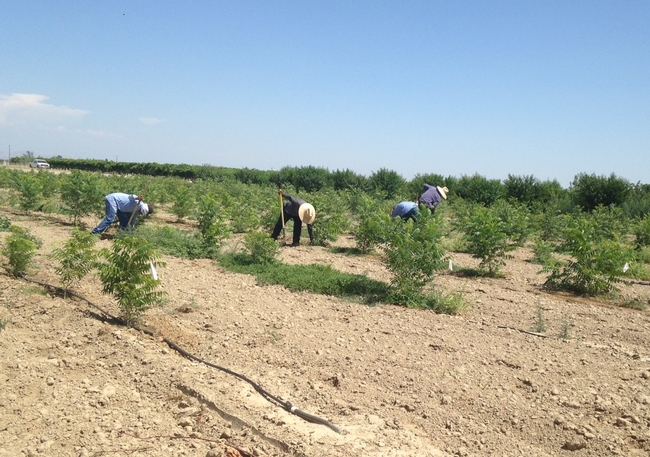
Posts Tagged: Richard Howitt
Drought to siphon $2.7 billion from California economy
About 4 percent of the California agricultural economy - $1.8 billion - will be lost in 2015 due to the California drought, and combined with ripple effects in affiliated industries, will produce a $2.7 billion economic hit, reported the San Jose Mercury-News.
The article was based on an economic analysis by a team of scientists that included Daniel Sumner, director of the Agricultural Issues Center, a UC Agriculture and Natural Resources special program.
The downturn will be felt most sharply in the San Joaquin Valley, where five of the state's top six agricultural counties are situated.
"Tulare is taking the hardest hit," said the report's lead author Richard Howitt, a UC Davis professor emeritus of agricultural and resource economics.
Pumping groundwater has hepled keep some acreage in production. This study did not address the long-term costs of groundwater overdraft, such as higher pumping costs and greater water scarcity.
"The socioeconomic impacts of an extended ground (water use), in 2016 and beyond, could be much more severe," said Jay Lund of UC Davis, who lead the analysis.
National magazine profiles the California almond industry

UC Cooperative Extension advisors Gurreet Brar in Fresno County and David Doll in Merced County were among the sources. The reporter also spoke to Richard Howitt, an agricultural economist in the Department of Agricultural and Resource Economics at UC Davis.
Much of the article focused upon the industry's growth in recent years, especially in the face of the California drought. Farmers in the Central Valley once grew mostly wheat and cattle. But over time, they have gravitated toward more-lucrative crops.
"It's a normal, natural process driven by market demand," Howitt says. "We grow the stuff that people buy more of when they have more money."
But the shift impacts water use flexibility, the article said.
While farmers can forgo annual crops like tomatoes and melons during droughts, failing to irrigate trees means losing the entire orchard. That leaves many nut and fruit farmers with only one option: groundwater.
Brar told the reporter that the amount of water it takes to produce a pound of almonds has fallen by a third since 1990. But increases in the number of irrigated orchards has off-set those gains.
Doll, author of The Almond Doctor blog, said he believes the "nut boom" is still going strong.
No other region has California's combination of land, climate, infrastructure and research support. "India and China have tried, and failed," Doll said.
In 2014, groundwater saved the day
The total statewide economic cost of the 2014 drought is $2.2 billion, reported UC Davis economists. “What would it have cost if we didn't have access to groundwater?” asked lead author Richard Howitt this week at the Agribusiness Management Conference in Fresno. Howitt is a faculty member affiliated with the Agricultural Experiment Station, which is part of the UC Division of Agriculture and Natural Resources.
Howitt is professor and chair of the Department of Agricultural and Resource Economics at UC Davis.
He said groundwater is California farmers' insurance policy and urged the agriculture industry to take control of its management, reported Robert Rodriguez in the Fresno Bee. Howitt suggested farmers look at what Orange County does to manage its groundwater: Users pay for what they pump and if they use more than an allotted amount, they have to pay to replenish it.
The Orange County system is simple and equitable and can ensure continued, but measured, growth of permanent crops, Rodriguez reported.

Almond farmers relying on groundwater to cope with drought
California has emerged as the world's almond orchard because of near-perfect conditions for the crop, but in terms of production, it may have hit its peak, reported Jennifer Rankin in The Guardian.
"The future for farming almonds in California will always be there," said David Doll, UC Cooperative Extension farm advisor in Merced County. "It is more about coming into balance with our water resources."
The story quoted from a UC report that California farmers have spent an extra $500 million this year pumping extra water to cope with the drought.
Co-author of the study, Richard Howitt, professor in the Department of Agricultural and Resource Economics at UC Davis, cautioned against singling out particular crops.
"Don't blame almonds for the problem," he said. "The problem is one of water mismanagement."
He suggested changes in how California manages water so farmers monitor their groundwater use and replenish supplies when there is more rain.
"[The farmers] should be repaying what they are taking. And if they are taking more, as they always are in droughts, then they should be making plans to repay it back in wet years. If you treat your groundwater the way you treat your retirement account, then everything would be OK."
More information about water stress in almonds may be found in David Doll's blog, The Almond Doctor.
Caifornia drought transforms global food

Another source was Dan Sumner, director of the UC Agricultural Issues Center. He said shifts in California ag trends reverberate globally.
"It's a really big deal," Sumner said. "Some crops simply grow better here than anyplace else, and our location gives us access to markets you don't have elsewhere."
California is the United States' top dairy producer and grows half of the country's fruit. In 2012, almonds became the state's second-most valuable ag crop. The Washington Post reported that in the U.S., almond consumption has grown by more than 220 percent since 2005. In the late 2010s, almonds surpassed the long-running nut leader peanuts (not including peanut butter) in per capita consumption.
The Bloomberg article opened with the story the Fred Starrh's family farm in Kern County. The Starrh family was a prominent cotton grower for more than 70 years. The shifting global market and rising water prices prompted the family to replace more of their cotton plants with almonds.
"I can't pay $1,000 an acre-foot (of water) to grow cotton," said Starrh, 85.
California grows four-fifths of the world's almonds, the Bloomberg story said, using enough water to meet the needs of 75 percent of the state's population. An advocate for bigger water supplies for cities suggests in the story that farmers should be profitable, but it shouldn't come at the expense of urban water ratepayers.


